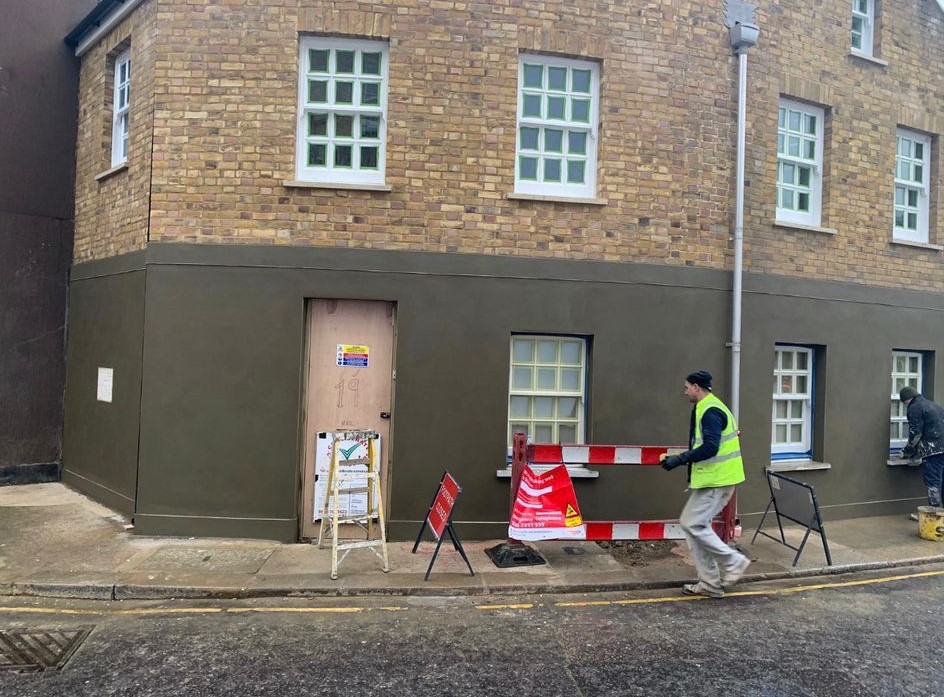In the world of construction, choosing the right materials can make all the difference in the quality and longevity of a building. One such material that has stood the test of time is hardwall plaster. This versatile material not only provides a robust solution for various construction needs but also adds a touch of elegance to any space. In this blog post, we’ll explore what hardwall plaster is used for, its key benefits, and why it remains a staple in both modern and traditional building practices.
What is Hardwall Plaster?
Hardwall plaster is a type of plaster commonly used in the construction industry due to its durability and strength. Unlike traditional plaster, hardwall is specifically formulated to provide a strong and long-lasting finish, making it ideal for walls that require additional reinforcement. Composed mainly of gypsum, it often includes additives like sand or other substances to enhance its binding properties, ensuring a firm and resilient surface.
In essence, thistle hardwall plaster serves as a protective layer that can be applied to various surfaces. Its primary function is to create a smooth, hard surface suitable for painting or further finishing. However, its versatility means it can be used in a variety of ways, from structural applications to decorative finishes.
Why Choose Hardwall Plaster?
There are several reasons why builders and homeowners alike choose hardwall plaster over other options. Firstly, its robustness ensures that walls are not only protected but also strengthened against everyday wear and tear. This makes it particularly useful in areas with high foot traffic or where walls are likely to be subjected to impact.
Another significant advantage of hardwall plaster is its thermal insulation properties. By improving the energy efficiency of a building, it helps in reducing heating and cooling costs. Additionally, its moisture resistance means it can be used in humid environments, preventing issues such as mold or mildew.
Finally, hardwall plaster offers excellent sound insulation, making it perfect for creating quieter indoor environments. Whether it’s used in residential or commercial settings, the acoustic benefits of hardwall plaster contribute to a more peaceful atmosphere.
Understanding Hardwall Plaster
Composition of Hardwall Plaster
Hardwall plaster is primarily composed of gypsum, a natural mineral known for its fire-resistant properties. The gypsum is often mixed with sand and other additives to enhance its strength and adhesion. These additional ingredients help the plaster bond more effectively to surfaces, ensuring a durable finish that can withstand various environmental conditions.
The precise composition of hardwall plaster can vary depending on its intended use. For example, plaster designed for exterior applications may include different additives than those used for interior walls. Nevertheless, the core component—gypsum—remains consistent, providing a reliable foundation for the material’s properties.
Types of Plaster and Where Hardwall Plaster Fits
In the realm of construction, several types of plaster are available, each with its unique characteristics. Bonding plaster, for example, is often used as a base layer to prepare surfaces before applying a finishing coat. Skim coat plaster, on the other hand, is used to create a smooth finish over existing surfaces.
Hardwall plaster fits into this landscape as a robust option for foundational work. It’s particularly suited for load-bearing walls and other structural elements that require additional strength. Compared to bonding or skim coat plaster, hardwall provides a harder, more resilient surface, making it an excellent choice for both new constructions and renovations.
History and Evolution of Hardwall Plaster
The use of plaster in construction dates back centuries, with ancient civilizations relying on natural materials to create durable surfaces. Over time, advancements in technology and materials have led to the development of specialized plasters like hardwall. This evolution has allowed builders to achieve greater precision and quality in their work, meeting the demands of modern architecture.
Today, hardwall plaster continues to evolve, incorporating new additives and techniques to enhance its performance. Its enduring popularity is a testament to its effectiveness and versatility in a wide range of applications.
Primary Uses of Hardwall Plaster
Structural Uses in Construction
Hardwall plaster is widely used in the construction industry for its ability to reinforce walls and other structural elements. Its strength makes it ideal for load-bearing walls, where additional support is necessary to maintain the integrity of a building. By providing a solid foundation, hardwall plaster ensures that structures can withstand various stresses and impacts.
In addition to load-bearing applications, hardwall plaster is also used for non-load-bearing walls. It creates a sturdy barrier that can be finished with paint or other decorative materials, enhancing both the function and appearance of a space.
Residential and Commercial Applications
Hardwall plaster is a popular choice for both residential and commercial buildings. In homes, it can be used to create smooth, durable surfaces in living rooms, kitchens, and bathrooms. Its moisture-resistant properties make it particularly suitable for areas prone to humidity, such as bathrooms and basements.
In commercial settings, hardwall plaster is often used in offices, retail spaces, and other environments where durability and aesthetics are important. It provides a clean, professional finish that can be customized to suit the design and branding of a business.
Exterior vs. Interior Use
While hardwall plaster is commonly used for interior applications, it can also be applied to exterior surfaces. Its strength and weather-resistant properties make it suitable for outdoor walls, facades, and other elements exposed to the elements. However, it’s essential to use the appropriate mix of additives to ensure the plaster withstands environmental conditions.
For interior use, hardwall plaster offers flexibility in terms of design and finish. It can be painted, textured, or left as a smooth surface, providing various options for customization and enhancement.
Key Benefits of Using Hardwall Plaster
Durability and Strength
One of the primary benefits of hardwall plaster is its durability. The combination of gypsum and additives creates a strong, resilient surface that can endure daily wear and tear. This makes it an excellent choice for high-traffic areas or spaces where walls are likely to sustain impact.
Hardwall plaster’s strength also contributes to the overall structural integrity of a building. By reinforcing walls and other elements, it helps prevent cracks, sagging, and other common issues associated with weaker materials.
Thermal Insulation Properties
Hardwall plaster offers significant thermal insulation benefits, improving the energy efficiency of a building. By reducing heat loss or gain, it helps maintain a comfortable indoor temperature, leading to lower heating and cooling costs. This is especially valuable in regions with extreme temperatures, where energy efficiency can have a considerable impact on utility bills.
In addition to its insulating properties, hardwall plaster also contributes to a more stable indoor climate. By minimizing temperature fluctuations, it helps create a comfortable living or working environment year-round.
Moisture and Sound Insulation
Another advantage of hardwall plaster is its moisture-resistant properties. In areas prone to humidity, such as kitchens, bathrooms, and basements, hardwall plaster prevents water infiltration and the associated risks of mold or mildew growth. This protection is essential for maintaining the integrity and health of a building.
Hardwall plaster offers excellent sound insulation as well. By dampening noise transmission between rooms, it contributes to a quieter indoor environment. This is particularly beneficial in residential settings, where reducing unwanted noise can enhance comfort and privacy.
Application Techniques for Hardwall Plaster
Preparing the Surface for Hardwall Plaster
Before applying hardwall plaster, it’s essential to prepare the surface properly. This involves cleaning the area to remove dirt, dust, and debris that could interfere with adhesion. Additionally, any cracks or imperfections should be repaired to create a smooth, even substrate.
In some cases, a bonding agent may be applied to enhance the adhesion of the plaster to the surface. This is particularly important when working with non-porous materials, such as concrete or metal.
Mixing and Ratio Guidelines
Correctly mixing hardwall plaster is crucial for achieving the desired consistency and performance. The typical ratio involves combining gypsum, sand, and water, along with any additional additives specified by the manufacturer. It’s essential to follow the recommended guidelines to ensure a uniform mixture that applies smoothly.
Mixing should be done thoroughly to eliminate lumps and achieve a consistent texture. This ensures that the plaster adheres evenly to the surface, preventing issues such as cracking or peeling.
Application Tools and Equipment
Applying hardwall plaster requires specific tools and equipment to achieve a professional finish. Common tools include a hawk and trowel, which are used to apply and spread the plaster evenly. A float may also be used to smooth the surface and remove any air bubbles or imperfections.
For larger areas, specialized equipment such as a plaster sprayer may be employed to speed up the application process. Regardless of the tools used, careful attention to detail is necessary to achieve a smooth, even finish.
Applying Hardwall Plaster Step-by-Step Process
The application of hardwall plaster involves several steps, beginning with the preparation of the surface and mixing of the plaster. Once these steps are complete, the plaster is applied to the wall using a hawk and trowel, spreading it evenly across the surface.
After the initial layer is applied, it’s essential to smooth out any imperfections using a float or other finishing tool. The plaster should be left to set and cure according to the manufacturer’s recommendations, ensuring a strong, durable finish.
Drying and Curing Requirements
Proper drying and curing are critical for achieving the full strength and durability of hardwall plaster. The drying time can vary depending on factors such as temperature, humidity, and the thickness of the application. It’s essential to follow the manufacturer’s guidelines to ensure optimal results.
In general, the plaster should be protected from direct exposure to sunlight or extreme temperatures during the curing process. This helps prevent cracking or other issues that could compromise the integrity of the finish.
Specialized Uses of Hardwall Plaster
Hardwall Plaster in Restoration and Renovation
Hardwall plaster plays a significant role in the restoration and renovation of older buildings. Its strength and durability make it an excellent choice for reinforcing and repairing aging structures, ensuring their longevity and stability.
In addition to structural repairs, hardwall plaster can be used to recreate historical finishes and textures, preserving the aesthetic integrity of heritage buildings. This ability to blend strength with style makes it a valuable tool in the preservation of architectural history.
Using Hardwall Plaster in High-Humidity Areas
In high-humidity areas such as kitchens, bathrooms, and basements, hardwall plaster provides essential moisture protection. Its resistance to water infiltration helps prevent issues such as mold and mildew, contributing to a healthier indoor environment.
By offering both durability and moisture resistance, hardwall plaster is a reliable choice for areas prone to humidity. It ensures that walls remain strong and protected, even in challenging conditions.
Decorative Techniques with Hardwall Plaster
Beyond its practical applications, hardwall plaster can also be used for decorative purposes. Various texturing and finishing techniques can be employed to create unique, visually appealing surfaces. From intricate patterns to smooth, seamless finishes, hardwall plaster offers a range of possibilities for enhancing the aesthetic appeal of a space.
By experimenting with different techniques, builders and homeowners can achieve a personalized look that reflects their style and preferences.
Maintenance and Care
How to Maintain Hardwall Plaster Walls
Maintaining hardwall plaster walls involves regular cleaning and inspection to ensure their continued strength and appearance. Dust and dirt should be removed using a soft cloth or vacuum, while any stains or marks can be gently wiped away with a damp cloth.
Periodic inspections are essential for identifying potential issues such as cracks or moisture infiltration. Addressing these problems promptly can prevent further damage and prolong the life of the plaster.
Common Issues and Repairs
Common issues with hardwall plaster include cracks, moisture problems, and surface imperfections. These can often be addressed with simple repairs, such as filling cracks with a suitable filler and repainting the affected area.
In cases of more significant damage, professional assistance may be required to ensure the integrity and appearance of the plaster. By addressing issues promptly, homeowners can maintain the strength and aesthetic appeal of their walls.
Comparing Hardwall Plaster to Alternative Wall Finishes
Hardwall Plaster vs. Drywall
When comparing hardwall plaster to drywall, several key differences emerge. Hardwall plaster offers greater durability and strength, making it suitable for structural applications and high-traffic areas. In contrast, drywall is typically quicker and more cost-effective to install, but it may not offer the same level of resilience.
The choice between hardwall plaster and drywall ultimately depends on the specific needs and priorities of a project. For those seeking a robust, long-lasting finish, hardwall plaster remains a preferred option.
Hardwall Plaster vs. Lime Plaster
Lime plaster is another alternative to hardwall plaster, offering unique benefits such as increased breathability and natural antimicrobial properties. However, lime plaster can be more labor-intensive to apply and may require additional maintenance over time.
Comparing the two, hardwall plaster provides greater strength and moisture resistance, making it a practical choice for modern construction. Nevertheless, lime plaster’s environmental benefits and historical appeal make it a valuable option for certain projects.
Hardwall Plaster vs. Cement Plaster
Cement plaster is a popular choice for exterior applications, offering excellent strength and weather resistance. However, it can be prone to cracking and may not provide the same level of thermal and sound insulation as hardwall plaster.
For interior applications, hardwall plaster offers a more versatile and aesthetically pleasing solution. Its ability to withstand moisture and provide insulation makes it a practical choice for a wide range of environments.
Safety and Environmental Considerations
Environmental Impact of Hardwall Plaster
When considering the environmental impact of hardwall plaster, it’s essential to evaluate the materials and processes involved in its production. Gypsum, the primary component of hardwall plaster, is a naturally occurring mineral that is both abundant and non-toxic. This makes hardwall plaster a relatively eco-friendly option compared to some other construction materials.
Additionally, hardwall plaster can be recycled, reducing waste and minimizing its environmental footprint. By choosing sustainable sourcing and disposal methods, builders can further enhance the eco-friendliness of this versatile material.
Safety Precautions When Working with Hardwall Plaster
When working with hardwall plaster, it’s important to adhere to safety precautions to protect oneself and others. This includes wearing appropriate personal protective equipment (PPE), such as gloves, goggles, and a dust mask, to prevent skin irritation and respiratory issues.
Adequate ventilation is also crucial, especially when mixing and applying the plaster. By ensuring proper airflow, workers can minimize exposure to dust and fumes, maintaining a safe working environment.
Summary
In summary, hardwall plaster is a versatile and durable material that offers numerous benefits for modern construction. Its strength, thermal insulation, and moisture resistance make it a valuable choice for a wide range of applications, from structural work to decorative finishes.
With a rich history and ongoing evolution, hardwall plaster remains a preferred option for builders and homeowners seeking a reliable, long-lasting solution. By understanding its uses, benefits, and proper application techniques, one can make informed decisions that enhance the quality and longevity of their construction projects.
For those considering hardwall plaster for their next project, consulting with experienced professionals can provide valuable insights and guidance. From initial preparation to final finishes, expert support ensures that hardwall plaster is applied effectively and efficiently.
Frequently Asked Questions (FAQs)
What types of surfaces are suitable for hardwall plaster?
Hardwall plaster can be applied to a variety of surfaces, including brick, concrete, and masonry. It’s important to ensure that the surface is clean and free of any contaminants to ensure proper adhesion.
Can hardwall plaster be applied directly to bricks?
Yes, hardwall plaster can be applied directly to bricks. However, it’s essential to prepare the surface adequately, removing any dust or debris and, if necessary, applying a bonding agent.
How long does hardwall plaster take to dry completely?
The drying time for hardwall plaster can vary depending on factors such as temperature, humidity, and the thickness of the application. Generally, it takes anywhere from 24 to 48 hours to dry completely. It’s crucial to follow the manufacturer’s guidelines for optimal drying and curing.
Is hardwall plaster suitable for DIY applications?
While hardwall plaster can be applied by DIY enthusiasts, it does require some skill and experience to achieve a professional finish. For best results, it’s recommended to consult with a professional or seek guidance if you’re unfamiliar with the process.
Does hardwall plaster provide soundproofing?
Hardwall plaster offers some soundproofing benefits, reducing noise transmission between rooms. While it may not provide complete soundproofing, it contributes to a quieter indoor environment, making it an excellent choice for residential applications.


